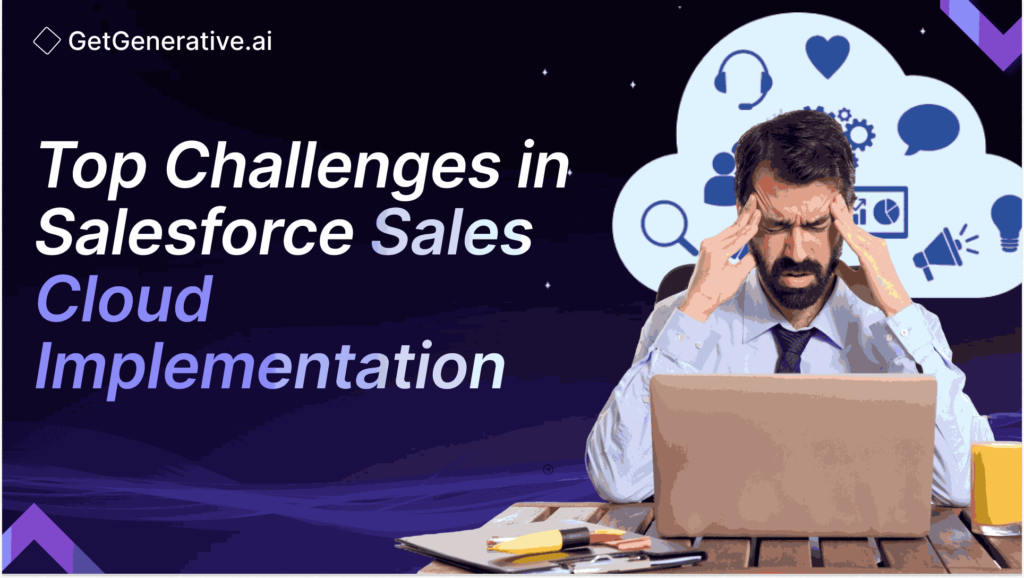Top Challenges in Salesforce Sales Cloud Implementation
Implementing Salesforce Sales Cloud is an exciting opportunity for organizations looking to enhance their sales processes, improve efficiency, and drive growth. However, as rewarding as it is, the journey of implementation comes with its fair share of obstacles. Studies have shown that up to 70% of CRM platform implementations fail, often due to common pitfalls that organizations face.
In this blog, we’ll explore the key challenges of Salesforce Sales Cloud implementation and offer actionable insights to overcome them effectively, ensuring your journey is as seamless and successful as possible.
Why Salesforce Sales Cloud Implementations Can Be Challenging
Salesforce Sales Cloud has the potential to transform the way businesses handle their sales pipelines, but achieving this level of innovation requires more than a straightforward process. Every stage, from goal setting to technical integrations, calls for thorough planning and careful execution.
Let’s dive into the most significant challenges organizations face and learn how to tackle them head-on.
1. Lack of a Clear Vision for Salesforce Strategy
Why This Happens
Many organizations begin their Salesforce implementation journey without a clearly defined vision of the outcomes they aim to achieve, leading to confusion and inefficiencies. Without clear objectives, the implementation becomes directionless, leading to underwhelming results.
How to Overcome It
- Develop a laser-focused strategy outlining how Salesforce aligns with your business goals.
- Establish SMART goals—those that are Specific, Measurable, Achievable, Relevant, and Time-bound—to steer your implementation efforts effectively and stay aligned with your objectives.
- Identify key success metrics, such as increased customer satisfaction or streamlined sales processes, to measure ROI.
2. Poor Change Management and Internal Resistance
Why This Happens
Introducing Salesforce often disrupts existing workflows, causing employees to resist change. When users feel excluded from the implementation process, adoption rates plummet.
How to Overcome It
- Make the implementation a company-wide initiative rather than a top-down directive.
- Communicate the benefits of Salesforce early and frequently to employees.
- Invest in training programs and provide ongoing support to ease the transition.
- Involve employees as champions of change, turning them into advocates for the new system.
Also Read – The Ultimate Salesforce Sales Cloud Features Cheat Sheet
3. Challenges in Data Migration and Integration
Why This Happens
Transferring data from legacy systems and ensuring seamless integration with Salesforce stands out as one of the most complex technical challenges in the implementation process. Poor data quality, duplicate records, and integration mishaps often lead to delays.
How to Overcome It
- Conduct a thorough data audit before migration to identify duplicates and inconsistencies.
- To maintain the accuracy and consistency of data throughout, it’s essential to create a robust data management plan that addresses both immediate and long-term needs.
- Use Salesforce tools like Data Loader or third-party integration platforms to simplify the migration.
- Regularly perform system validation checks to maintain data quality.
4. Over-Customization of Salesforce Features
Why This Happens
Salesforce offers extensive customization options, but over-customization can complicate workflows, confuse users, and increase costs.
How to Overcome It
- Focus on core features and customize only when it directly supports your business goals.
- Take an incremental approach, prioritizing essential features during the initial rollout and adding advanced functionalities later.
- Collaborating with a skilled Salesforce implementation partner is crucial for navigating the complexities of customization, ensuring your setup is tailored to your unique business needs.
5. Choosing the Right Salesforce Implementation Partner
Why This Happens
The expertise of your implementation partner can make or break your Salesforce project. Partnering with inexperienced or underqualified consultants often leads to poor communication, missed deadlines, and budget overruns.
How to Overcome It
- Select a partner with proven experience and certifications in Salesforce implementation.
- Establish a collaborative framework to ensure smooth communication and alignment of goals.
6. Scope Creep and Misaligned Stakeholder Expectations
Why This Happens
Frequent changes in project requirements can derail the implementation process, causing delays and budget overruns.
How to Overcome It
- Develop a detailed implementation roadmap aligned with your company’s strategic goals.
- Establishing a structured engagement model fosters clear communication and cooperation between the implementation team and key stakeholders, paving the way for a successful rollout.
- Regularly monitor progress with predefined follow-ups to address deviations early.
Also Read – Tips for Successful Salesforce Sales Cloud Implementation
7. Low User Adoption Rates
Why This Happens
Even the most robust Salesforce system is ineffective if users don’t adopt it. Poor training, complex interfaces, and resistance to change are common barriers to adoption.
How to Overcome It
- Offer role-specific training sessions to familiarize users with Salesforce functionalities relevant to their work.
- Simplify processes by minimizing unnecessary customizations.
- Use in-app guidance tools like Salesforce Walkthroughs to assist users in real time.
8. Addressing Skill Gaps in the Workforce
Why This Happens
Many employees struggle to adapt to new technologies, leading to underutilization of Salesforce’s features.
How to Overcome It
- Conduct a gap analysis to identify skill shortages in your workforce.
- Organize upskilling programs tailored to the custom features of your Salesforce implementation.
- Align training initiatives with your company’s strategic objectives to ensure long-term success.
9. Testing and Quality Assurance Challenges
Why This Happens
Skipping thorough testing due to time constraints often results in bugs and functionality gaps post-implementation.
How to Overcome It
- Use User Acceptance Testing (UAT) to validate functionalities against real-world use cases.
- Simulate business scenarios to ensure the system meets your needs.
- Utilize a sandbox environment to test configurations without affecting live data.
10. Maintaining Data Integrity Post-Implementation
Why This Happens
Data inconsistencies and errors can undermine the effectiveness of your CRM.
How to Overcome It
- Automate data validation processes to catch errors early.
- Integrate Salesforce with external tools like billing software or email clients for seamless data flow.
- Regularly audit your data to maintain accuracy and reliability.
Also Read – Salesforce Sales Cloud Implementation Template
Conclusion
By addressing these challenges head-on—whether it’s setting a clear vision, managing change, or ensuring data quality—you can unlock Salesforce’s full potential and drive lasting success. Remember, preparation, collaboration, and continuous improvement are the keys to a seamless Salesforce journey.
To learn more, visit GetGenerative.ai today!
FAQs
1. Why do many Salesforce implementations fail?
Poor planning, unclear objectives, and resistance to change are some of the most common reasons implementations fail.
2. How can user adoption of Salesforce Sales Cloud be guaranteed?
Offer specialized training tailored to specific roles, simplify processes to make workflows more intuitive, and actively engage employees in the implementation journey from the outset.
3. What is the role of a Salesforce implementation partner?
A qualified implementation partner provides the expertise needed to customize Salesforce effectively while ensuring the project aligns with your broader business goals and delivers measurable results.
4. How do I avoid data migration issues during implementation?
Conduct a thorough data audit, use data migration tools, and involve experts to ensure accuracy and consistency.
5. What steps should I take to manage scope creep?
Develop a clear implementation roadmap, monitor progress regularly, and establish strict project boundaries to stay on track.




